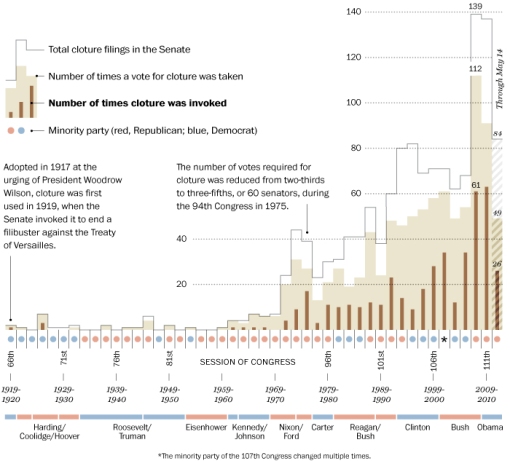In civics class, every child learns that it takes 51 votes to pass something in the Senate, with the Vice President breaking ties if necessary. Of course, those civics lessons no longer apply to today’s Senate. Because of the Senate’s rules surrounding filibusters and cloture, it now takes 60 votes to pass a motion in the Senate. These rules directly contradict of the intentions of the framers of the Constitution and have made the Senate increasingly dysfunctional and ineffective.
I’ve written before that for the good of the country, the filibuster needs to be gotten rid of. Since its in the news again, here is a rundown on what the filibuster is and why you should care.
What, exactly, is the filibuster?
The filibuster is a Senate rule that allows unlimited debate on an issue before the Senate. This unlimited debate can only be ended by the votes of 60 Senators (called invoking “cloture”). From the mid 1800s to the mid 1900s the filibuster was primarily used by lone Senators or small groups of Senators to block or call attention to legislation they disapproved of. Since 2009, the filibuster has been used to block the Senate from voting on any bills or nominations unless they have 60 votes. Predictably, this has result in intense and debilitating gridlock in Congress.
Where did the filibuster come from?
The filibuster is not in the Constitution. It came about (like anything else) by accident. As Ezra Klein writes:
In 1806, the Senate, on the advice of Aaron Burr, tried to clean up its rule book, which was thought to be needlessly complicated and redundant. One change it made was to delete something called “the previous question” motion. That was the motion senators used to end debate on whatever they were talking about and move to the next topic. Burr recommended axing it because it was hardly ever used. Senators were gentlemen. They knew when to stop talking.
That was the moment the Senate created the filibuster. But nobody knew it at the time. It would be three more decades before the first filibuster was mounted — which meant it was five decades after the ratification of the Constitution.
This extremely powerful and controversial rule was created by accident and should never have come into existence.
When did the Filibuster achieve its current form?
As I said, the filibuster didn’t always function like it does today. In the earliest days, it was a tool for a single Senator (or group of Senators) to use to oppose a particular bill that he didn’t like. After Senators tried to block the Treaty of Versailles from being considered, “cloture” was developed. In its early days, cloture allowed 67 Senators to cut off debate on a motion, ending a particular filibuster. Most famously, the filibuster was used by Southerners to block civil rights legislation in the 1950 and 1960s.
Along the way, the filibuster evolved from being something that a single Senator or group of Senators might use to block a single bill and instead because a tool the entire minority party in the Senate would use to block the majority from doing what it wanted. This turned the balance of power in the Senate on its head, giving the minority party a veto over what got done in the Senate. Today, this forces an electorally victorious Senate majority to beg its defeated opponent for the right to pass legislation the minority opposes.
When it seemed that the number of filibusters was getting out of hand in 1975, the Senate lowered the number of votes required for cloture to 60. In that session of Congress, there had been about 40 filibusters.

Via the Washington Post
Now, the minority party in the Senate stages nearly 140 filibusters per session of Congress. Nearly every act of Congress, no matter how minuscule, is subjected to a filibuster. In this environment, its no wonder people complain about Congress not doing anything to help the American people.
Why the filibuster is important
Voters elect a party to power and expect them to govern. If they govern well, voters will reward them at the next election. If they govern poorly, voters will punish them. Republicans figured out in 2009 that if they simply block everything the majority party wants to do, then it starts to look like the majority party is doing a very bad job at governing. Few bills are passed, and the ones that are have to be loaded down with pork in order to scrounge up enough votes to get to 60. Americans’ problems start to go unaddressed and it starts to look like the majority party is doing a very bad job. So who do voters reward? The minority party.
In short, the filibuster allows the minority to sabotage the majority party, and by extension the will of the people and the good of the country, and then reap the rewards from voters’ dissatisfaction. Obviously, this is not how a democracy should work. Since it is nearly impossible to amass 60 votes in the Senate, this dynamic will be near-constant in the years ahead.
Would the Framers have liked the filibuster?
Obviously no framers were around to see a filibuster, but many of the filibuster’s defenders claim that the framers would have liked having it around. This claim doesn’t make any logical sense. After all, the framers had the opportunity to create the filibuster and they didn’t. Turns out that this claim doesn’t make any historical sense either. The framers thought about creating a super-majority requirement for the Senate and specifically rejected it. Again, from Ezra:
In Federalist 22, Alexander Hamilton savaged the idea of a supermajority Congress, writing that “its real operation is to embarrass the administration, to destroy the energy of government and to substitute the pleasure, caprice or artifices of an insignificant, turbulent or corrupt junta, to the regular deliberations and decisions of a respectable majority.”
In Federal 58, James Madison wasn’t much kinder to the concept. “In all cases where justice or the general good might require new laws to be passed, or active measures to be pursued, the fundamental principle of free government would be reversed. It would be no longer the majority that would rule; the power would be transferred to the minority.”
In short, the filibuster was a historical accident that was never intended to exist. It makes it impossible to legislate for our country and should be gotten rid of immediately by changing the rules for the Senate.



Yes, Republicans are to blame for the polarization in Congress
Of course since I’m a Democrat I’d think this, right? But hear me out, there is very good evidence showing that Republicans have become radically conservative over the past few decades. Democrats, on the other hand, have remained a centrist party and in many ways also have gotten more conservative. Our current problems with political polarization are almost entirely to blame on a Republican Party that has marched steadily to the right for over three decades. Additionally, anyone who says “both sides have become extreme lately” is clearly wrong.
A new study by two political scientists provides a good visualization of this trend:
Starting roughly in 1976, Republicans started becoming an unprecedentedly conservative party. In good years the GOP becomes more conservative, in bad years it becomes more conservative, without fail. Contrast that to the Democratic Party, which was about the same distance from the political center in the mid 60s as they were in 2009-2011. (Unlike with Republicans, electoral victories tend to move Democrats closer to center, while those representatives left after electoral defeats lend to be more liberal)
This is a nice graph of this trend, but more importantly, here are concrete examples of this phenomenon.
Health Care
The health care plan passed by Democrats in 2010 was much more conservative than the one proposed by Clinton in the early 1990s or any of other earlier Democratic plans. In fact, Obama’s plan was first proposed by Republicans in response to Clinton’s plan and first enacted into law by Republican Mitt Romney in Massachusetts. Today, Republicans say that same health care plan represents the death of liberty in America. Clearly on this issue, Republicans have moved to the right to oppose a plan they once favored and Democrats have moved right by passing a plan that Republicans once favored.
The Environment
You may remember that it was Republican Richard Nixon who first created the Environmental Protection Agency (EPA). Today, it is the Republicans who are talking about repealing the EPA or putting coal and oil executives in charge of the agency. This is clearly a major rightward turn for the party.
In the debate over man-made climate change, Republicans have gone from proposing solutions to the problem to denying that it even exists. A cap-and-trade solution to limiting carbon emissions was (you guessed it) originally a Republican idea. The 2008 Republican Presidential nominee John McCain even went around the country advertising cap-and-trade as his solution to climate change. In 2009-2010 Democrats moved and adopted cap-and-trade instead of their old idea of a carbon tax. Predictably, Republicans now say cap-and-trade is the greatest job-destroyer in America. On this issue (again) both parties have moved right.
Taxes
It used to be, taxes were just the way we paid for the things we wanted government to do. Democrats and Republicans went back and forth over how taxes should be structured and over their levels sometimes, but no party has ever denounced taxes as a moral evil and as antithetical to American values the way the current Republican Party is. Every Republican president up until Bush Sr. raised taxes at some point in his Presidency (to my knowledge). Now to do so would be blasphemy.
Democrats have also moved to the right on the issue of taxes. Democrats raised taxes under Clinton before Bush Jr. lowered them in 2001 and 2003. Now Democrats don’t even want to raise all of our taxes rates to the place they were under Clinton, they only want to raise taxes on those making more than $200,000/year. On this issue as well, both parties have moved far to the right. Republicans now see taxes as the devil and Democrats refuse to raise taxes on 98% of the population!
Immigration
In the 2000s, some Republicans favored compassionate and fair immigration reform. Now, you’d be hard pressed for a Republican spouting anything less than “round ’em all up,, shove ’em in jail and post automatic machine guns to mow down anyone trying to cross the border.” Republicans are even against giving citizenship to children who were brought to the US as children have lived here almost their entire lives and agree to go to college or serve in the US military (a bill called the DREAM Act).
Under former President Bush, many Republicans favored an even looser version of the DREAM Act. This version would have only required prospective DREAMers to graduate high school and did not include many other provisions restricting access to this benefit. Democrats still favor the DREAM Act, but Republican support for it has all but disappeared.
Conclusion
Looking only at issues overlooks procedural ways the Republicans have increased polarization, such as how they now filibuster every small issue that gets brought up in the Senate, where before only major issues were seen as deserving of a filibuster.
As should be obvious, Republicans have moved sharply to the right over the past couple decades. I cannot think of any issue where the Democrats have similarly moved to the left (except on gay rights, I suppose). As studies show and party rhetoric confirms, Republicans are mostly responsible for the polarization and dysfunction in our government today. The solution to these problems involves finding someway to change the Republican Party.
government
policy
politics
republicans